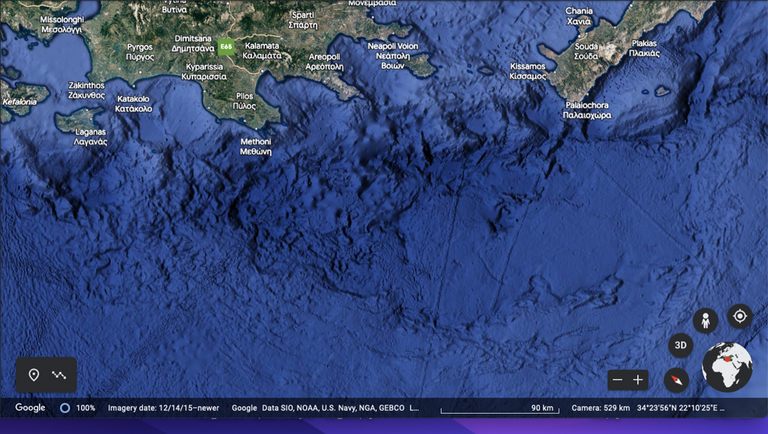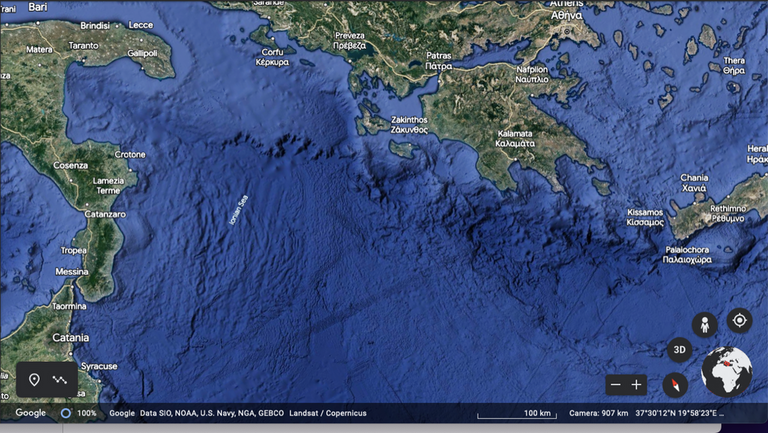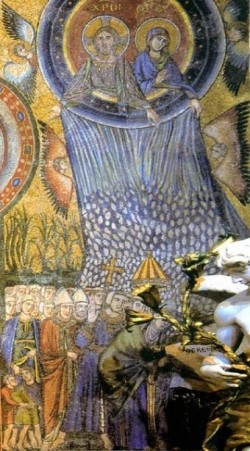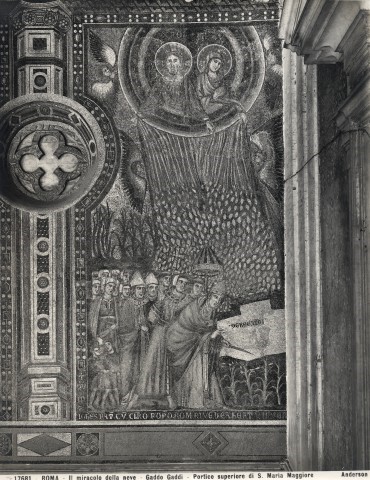Hermann Burchard:* The Unknown and Unknowable AD 365 comet impact Tervingi Goths invasion destroys Western Roman Empire, Alexandria tsunami, great earthquake of Crete, extinction zones of unknown extent, Eurasia climate collapse, Huns flee Central Asia.
* Dept. of Mathematics, Oklahoma State University, STILLWATER, OK 74078, USA
email: vollskeptiker@gmail.com
1. Comet impact created the 365 AD tsunami and Crete earthquake
On 21 July AD 365 a quake of magnitude ∼ 8 struck near Crete. It destroyed every city on the island, with widespread devastation in a large region from the Balkans to N Africa, from the Nile to NE Libya. The extreme W Coast of Crete was lifted up by 10 m & the quake generated a tsunami that carried ships 3 km inland at Alexandria, Egypt. The extraordinary geographic extent of destruction, from Dalmatia to the Dead Sea, has impressed & confused mankind, and led to various attempts of explanation, including global catastrophes of unknown kinds.
Numerous authors in antiquity as well as recently describe & discuss the Cretan quake, tsunami & widespread damage. Recent geological interpretations blame a fault system S of the island.
‘‘The quake left a deep impression on the late antique mind, and numerous writers of the time referred to the event in their works. . . The interpretation of the surviving literary evidence is complicated. . . ” [Wikipedia]
Here, in this note, we present that a large cosmic object, a meteorite or asteroid, impacted planet Earth on that day, most likely a comet. In the sea bottom SW of Crete lies a deep hole, 175 km wide, visible in Google Earth high resolution imagery.
This is the impact crater, excavated when the comet exploded, releasing its kinetic energy, & lifting up the W coastal edge of Crete by 10 m. From the earthquake’s reported magnitude M = 8, we can estimate the energy needed to generate it: E ≈ 1 gigaton of TNT equivalent, avg. kinetic energy of a meteorite of diameter about d = 230 m. At the
upper limit, near M = 9, the seafloor cannot sustain a quake without breaking up, E > 15 gigaton of TNT equivalent, M > 8.78.

The typically fragile comet seems to have broken up in several fragments during its
approach, judging by the marks visible on the floor of the impact crater, as shown in
Google Earth’s high resolution image of the Mediterranean sea floor, a common formation.
Before exploding near the island of Crete, the comet’s bow shock hit S Italy at the
megalopolis of Tarentum, present-day Taranto, destroying it & leaving no survivors to
tell the story. The orbit came in on an extremely low, shallow angle from the NNW
heading SSE. The bow shock carved out an impact trench that stretches for 900 km from
Taranto to Crete, where the impactor exploded. The nearly square-shaped large bay, the
Gulf of Taranto, was cut by the bow shock, forming the start of the trench. The bay is
not mentioned much in maps & its name is not greatly in use, reflecting that it did not
exist in Antiquity before the impact year of AD 365.
The Romans conquered the city in 272 BC during the Pyrrhic War:
‘‘After taking Taranto, the Romans destroyed the walls and connected it to the port of Brindisi.”
[Hellenic Wikipedia]
As we can see, the Adriatic port of Brindisi is mentioned in this ancient quote, not the future, but nearer, bay of post AD 365.
The namelessness of the large bay is due to the fact that there was a large region without any survivors in S Italy. Neither did the Salento peninsula exist in its preent form, the Heel of Italy, a part of Apulia. 1)
In AD 365, Tarentum was large & powerful. The current area of Taranto is a small
fraction of that once occupied by her metropolitan precursor. A population of 300,000
inhabitants would have been annihilated at the impact. Centuries later, in the year 547,
during the war against the Ostrogoths under Justinian, the Byzantine commander of
Taranto built new walls on a smaller scale. He could not have defended the large, vacant
areas of Tarentum.

Figure 2: The 900 km impact trench and crater of 21 July 365 AD
The Eastern edge of the impact trench is clear indication that there were ancient
Ionian Hellenic territories obliterated. This includes the island of Ithaka where Odysseus
was king, that has never been identified, with recent research still of interest. From what
is known, it now appears that it was destroyed in the comet impact on July 21, AD 365.
The island’s status, having been missing for centuries after the impact, is one element of
holistic confirmation of the comet, including the trench cut by the bow shock, in which
Ithaka must have been disintegrated.
2. Eyewitness statement by Ammianus Marcellinus
The actual impact event & tsunami of July 21, AD 365, is vividly described by the
Roman military officer Ammianus Marcellinus (330-400?):
Terrible destruction suddenly broke out in the whole (then known) world, the like of which no one finds anywhere, neither in legends nor in true historical events. Shortly after the first light of dawn, preceded by thunder and lightning, the whole Earth was shaken. The sea retreated and its waters were drawn to such an extent that its bottom was exposed. One could thus see buried deep in the mud many sea creatures and many mountain ranges and valleys which, while always covered with water, became visible as the sun's rays fell upon them for the first time. Many ships drifted out and many people roamed the few waters that remained gathering fish and other sea creatures, but the sea waves came back high and rushed over the shallow waters, islands and extensive landmasses leveling many buildings or anything in their path. Enormous quantities of water killed, on their return, many thousands of people. When the fury of the waters subsided, some wrecked ships and corpses of castaways were seen. Some large ships had been hurled by the wave on the roofs of houses, as happened at Alexandria, and others as far as two miles inland.
[Google Translate from Hellenic Wikipedia]
(A more complete translation of this passage of Ammianus Marcellinus is available on Q-mag at: What happened on July 21st 365 AD? )
We do not know where Ammianus was located on July 21, AD365. In AD 363, the Roman army under Emperors Julian & Jovian suffered a disastrous defeat in a war against the Sassanian Persian King Shapur II, which Ammianus, as a Roman officer, had survived. Very likely, he was still in Syria when the comet struck, and became a direct eye-witness, and recipient of direct and indirect accounts of the ensuing damage all around the Mediterranean Sea basin.
3. The Unknown cosmic impact of July 21st, 365 AD was unknowable
Immediately, numerous consequences arose. Harsh climate downturns known as
cosmic winter or impact winter fell over the globe. The Huns in Central Asia fled their
now suddenly uninhabitable environment. In the process, they overthrew Ermanarich’s
Greuthungi East Gothic Empire in Russia and Ukraine. They had been in an expansionist
mood already, having defeated the Alans five years earlier.
The Tervingi West Goths tribes poured southward across the Danube in AD 366-7. The Danube had swollen to over a mile wide due to the incessant rains, as told by historian Edward Gibbon. The Tervingi called on the help of the Roman Army to cross the river. They bribed the officers by letting them sleep with their wives, just one of numerous tidbits that showed the extremities at which survivors were reduced in the aftermath of the catastrophe; Gibbon, again, giving us this revealing account. Thirteen years later, in AD 378, they defeated the Roman legions in the disastrous battle of Adrianople, killing Emperor Valens, hailing the beginning of the end of the Roman empire.
The Pannonian plains in the Balkans were depopulated, only brambles grew for years afterwards & no fish lived in the poisoned rivers (something which mere earthquakes could hardly account for). Some of Gibbon's contemporaries, disbelieving his account, joked that the great historian seemed to believe that the fish had died out of fear of the Goths’ spears.
No historical record of the impact & related events could form due to large extent of the extinction
areas. Perhaps now that we can posit the existence & causative powers of the comet,
intense archeological research will begin to discover extent as well as details of the
unknown extinctions of human populations in various regions. Only small hints have
survived in written history. Pope Liberius (310-366) was never declared a saint by the
Church, the rare exception, but he built the beautiful basilica of Santa Maria Maggiore in
Rome, ‘‘ad nives,” in memory of August snows, impact winter.
The impact would have caused a regional mass-extinction of life with no survivors in
the immediate vicinity to tell the story. Which would explain why the impact did not make
it into the historical record. Although the earthquakes and tsunamis did: see Q-Mag: Saint Jerome vindicated.
British astronomers Victor Clube & Bill Napier, have proposed a ‘‘Giant Comet
Theory,” in their books, ‘Cosmic Serpent, & Cosmic Winter, supplying astronomical
background for the influence on human evolution of a giant precursor to Comet Encke
breaking up near Earth. This probably happened 40 k yrs BP, related to the Laschamp˜
geomagnetic excursion, & the Campi Flegrei explosion of 39,000 yrs BP. It has been
blamed for decimating Western Neanderthals by anthropologist John Hawks, UWisc.
4. Lybian Desert Glass identified as ejecta from 365 AD comet impact crater
The Earth’s eastward rotation must be taken into account, as the glass appears to be deposited W of the line. The velocity of the molten glass can only be estimated roughly. The 1,120 km projected trajectory, disregarding planetary rotation around the polar axis, may have been travelled in about 20 min, with a west-ward displacement of 500 km. This would be consistent with our equatorial velocity of 40,000 km in 24 hours, reduced by a factor of .9, taking account of the latitude of the glass. A more precise calculation can be done by specialists.

Figure 3: Lybian Desert Glass are ejecta of 21 July 365AD comet impact. Image: Wikipedia.
Figure 4."Snow in August" mosaic in Santa Maria Maggiore basilica (Rome) by Filippo Rusuti (ca. 1255-ca.1325).
References
Ammianus Marcellinus, Roman History, Book XXVI., Ch. 10, line 15619.
Shaw, B., Ambraseys, N., England, P. et al.: "Eastern Mediterranean tectonics and
tsunami hazard inferred from the AD 365 earthquake." Nature Geosci 1, 268–276 (2008).
https://doi.org/10.1038/ngeo151
Jacques François,& Bousquet Bernard: "Le raz-de-marée du 21juillet 365. Du cataclysme
local à la catastrophe cosmique." Mélanges de l’Ecole Française de Rome. Année
1984 96-1, pp. 423-461.
https://www.persee.fr/doc/mefr0223-51021984num9611412
Anne-Marie de Grazia: What happened on July 21, 365 A.D.? Q-Mag, Alfred de Grazia’s
Magazine of Quantavolution. (April 2012)
https://www.q-mag.org/what-happened-on-july-21-365-a-d.html
Hermann G.W. Burchard (2018). "Spratlies Archipelago as the Australasian Tektite
Impact Crater." Open Journal of Geology, vol 8, p. 1-8.
https://doi.org/10.4236/ojg.2018.81001
Hermann G.W. Burchard (2017). "Younger Dryas Comet 12,900 BP." Open Journal of
Geology, vol 7, p. 193-199.
https://dx.doi.org/10.4236/ojg.2017.72013
Hermann G.W. Burchard (2016). "Meteorite Impact Origin of The Yellowstone Hotspot."
Open Journal of Philosophy, vol 6, p. 18-26.
https://dx.doi.org/10.4236/ojpp.2016.64038.x
W. M. Napier (2015). "Giant comets and mass extinctions of life," Monthly Notices of the
Royal Astronomical Society, Vol. 448, no. 1, p. 27–36.
https://doi.org/10.1093/mnras/stu2681
W. M. Napier (2010). "Palaeolithic extinctions and the Taurid Complex," Monthly Notices
of the Royal Astronomical Society, vol. 405, no. 3, p. 1901–1906.
https://doi.org/10.1111/j.1365-2966.2010.16579.x
Bill Napier & David Asher (2009). "The Tunguska impact event and beyond," Astron-
omy & Geophysics, vol. 50, no. 1, p. 10-325



